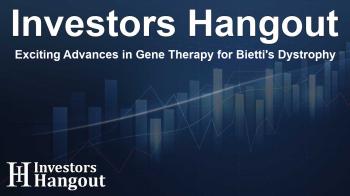Exciting Advances in Gene Therapy for Bietti's Dystrophy

Groundbreaking Clinical Development from Next Generation Gene Therapeutics
Next Generation Gene Therapeutics, known as NGGT, is making strides in the field of gene therapy, particularly for rare genetic conditions. Recently, they announced the release of promising clinical trial results concerning NGGT001, a potential treatment for Bietti's Crystalline Dystrophy (BCD). This innovative gene therapy aims to address the unmet medical needs of patients suffering from the devastating effects of this inherited eye disease.
Understanding Bietti's Crystalline Dystrophy
Bietti's Crystalline Dystrophy is a rare genetic disorder that primarily affects vision. It is characterized by progressive vision loss, often leading to significant impairment, and ultimately, legal blindness. The disease results from mutations in the CYP4V2 gene, and as of now, there are no approved therapies to adequately treat the condition, making the need for effective solutions critical.
Details of the Clinical Trial
The clinical trial conducted by NGGT involved a dose-escalation study with 12 participants diagnosed with genetically confirmed BCD. The subjects were administered a single subretinal injection of rAAV-hCYP4V2 (NGGT001), which introduces a functioning version of the CYP4V2 gene into the retina. This approach aims to restore proper functionality and mitigate the effects of the genetic defect.
Key Trial Outcomes
The findings from this trial are noteworthy. Over a follow-up period of 12 months, the safety profile of NGGT001 demonstrated promising results, with no serious adverse events reported. Notably, only one participant experienced mild intraocular inflammation, which was resolved without complications. Such a solid safety standing is crucial for the development of any new treatment.
Moreover, participants exhibited notable improvements in vision. On average, the treated eyes displayed an increase of 13.9 letters in the Best Corrected Visual Acuity (BCVA) scale after a year, compared to 6.3 letters in the untreated eyes. Importantly, those individuals who had measurable residual autofluorescence in the fovea—indicative of functional photoreceptors—continued to show sustained visual enhancements throughout the study.
Future Implications of NGGT001
These early outcomes suggest that NGGT001 could represent a paradigm shift in the treatment landscape for BCD. Such advancements provide hope that gene therapy may pave the way for effective solutions for conditions that currently have none. However, NGGT acknowledges the necessity for further research to confirm these encouraging results and to evaluate the long-term sustainability of the treatment effects.
Insights from NGGT Leadership
The leadership at NGGT is enthusiastic about these findings. Dr. Yiting Liu, Vice President of Translational Research, expressed excitement about the promise of NGGT001 as a potential pathway to treating BCD safely and effectively. Meanwhile, Dr. Lixin Jiang, the company’s CEO and Co-Founder, emphasized the importance of these results, highlighting the strong safety profile and observational gains in visual acuity across participants in the study.
NGGT001 functions as an AAV-based gene therapy focused on restoring the enzymatic fatty acid metabolism affected by the CYP4V2 mutation. By addressing the underlying genetic cause of BCD, it aims to restore normal eyesight and improve patients' quality of life significantly.
About Next Generation Gene Therapeutics
NGGT is at the forefront of developing cutting-edge gene therapies aimed at treating a range of challenging conditions, including metabolic, retinal, and neurodegenerative diseases. Their innovative pipeline includes various clinical and pre-clinical programs, with NGGT001 representing a promising Phase I/II-ready option for BCD. Additionally, the company is working on other therapies geared towards conditions like phenylketonuria (PKU) and familial hypercholesterolemia, showcasing their commitment to addressing diverse medical needs.
Frequently Asked Questions
What is Bietti's Crystalline Dystrophy?
Bietti's Crystalline Dystrophy is an inherited genetic eye disease that results in progressive vision loss, often leading to legal blindness due to mutations in the CYP4V2 gene.
What is NGGT001?
NGGT001 is an AAV-based gene therapy designed to provide a functional copy of the CYP4V2 gene, potentially offering a treatment option for Bietti's Crystalline Dystrophy.
How many participants were involved in the trial?
The trial involved 12 participants with genetically confirmed Bietti's Crystalline Dystrophy.
What were the key findings of the trial?
The trial indicated a favorable safety profile over 12 months, with only mild inflammation noted, and participants experienced an average vision improvement of 13.9 letters.
What are the next steps for NGGT regarding NGGT001?
NGGT plans to conduct further clinical trials to validate the promising initial results and investigate the long-term effects of the therapy on patients.
About Investors Hangout
Investors Hangout is a leading online stock forum for financial discussion and learning, offering a wide range of free tools and resources. It draws in traders of all levels, who exchange market knowledge, investigate trading tactics, and keep an eye on industry developments in real time. Featuring financial articles, stock message boards, quotes, charts, company profiles, and live news updates. Through cooperative learning and a wealth of informational resources, it helps users from novices creating their first portfolios to experts honing their techniques. Join Investors Hangout today: https://investorshangout.com/
Disclaimer: The content of this article is solely for general informational purposes only; it does not represent legal, financial, or investment advice. Investors Hangout does not offer financial advice; the author is not a licensed financial advisor. Consult a qualified advisor before making any financial or investment decisions based on this article. The author's interpretation of publicly available data shapes the opinions presented here; as a result, they should not be taken as advice to purchase, sell, or hold any securities mentioned or any other investments. The author does not guarantee the accuracy, completeness, or timeliness of any material, providing it "as is." Information and market conditions may change; past performance is not indicative of future outcomes. If any of the material offered here is inaccurate, please contact us for corrections.
